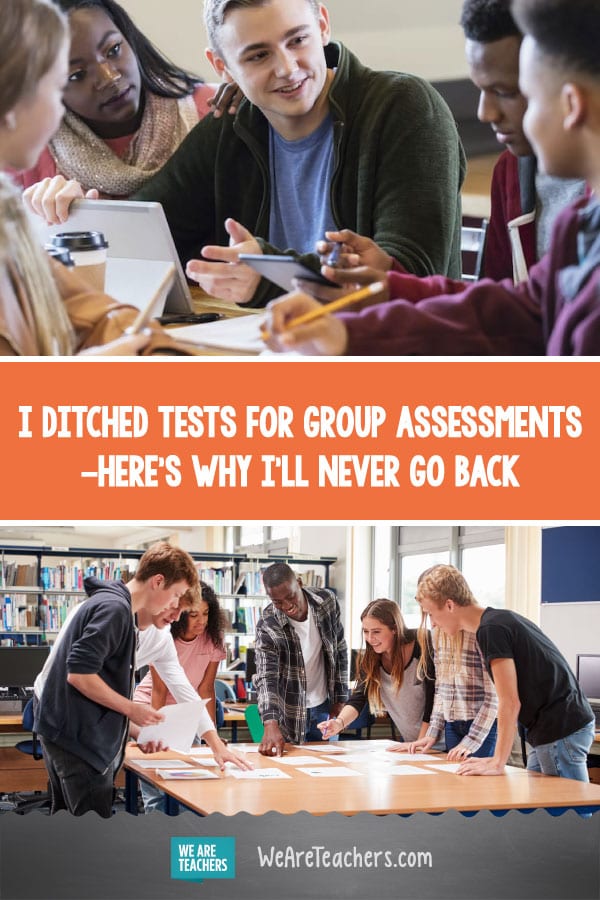When it came to test days, I used to find myself lining up desks in perfect rows, making sure the pencil sharpener functioned as needed, and hovering like a helicopter to make sure students weren’t cheating. Afterward, I’d spend time after school and on weekends correcting piles of work, only to see the results I already knew. The high achievers got the best grades, while the less-motivated kids floundered.
I knew there had to be a better way to use my—and more importantly, my students’—time. Consistent instructional time with them was already difficult. We seem to be constantly interrupted by assemblies, state-required standardized tests, absences, and tardies. I needed to get a handle on what they were learning, but traditional “skill and drill” wasn’t working anymore. That’s when I decided to ditch the traditional individual tests and replace them with group assessments. I’ve never looked back.
1. Group assessments make peer learning happen.
Peer learning is an important resource that we should be tapping into as frequently as possible. Most students who have a firm grasp on a skill or concept are eager to share their knowledge with other students. Conversely, students who may be confused or less confident in their abilities may be hesitant to ask questions in front of the whole class. EL students especially benefit from group assessments. They have the opportunity to ask questions in a low-risk situation where other students who speak the same language. This is a valuable way to scaffold instruction.
[contextly_auto_sidebar]
2. Group assessments increase student engagement.
While some students are eager to show all they know and relish the challenge of taking a test, others give up before they even start. I’ve had students put their heads down and sleep for the entire period! Not so with group assessments. Even the most reluctant students are eager to engage in a small group dynamic, particularly if the assessment is structured as a puzzle or a game. Instead of being accountable to just the teacher, students are accountable to each other.
3. For students with trauma, testing anxiety decreases.
According to the National Survey on Children’s Health, nearly 47 percent of all children have experienced trauma. Some students suffer panic attacks when taking high-stakes tests, while others shut down completely. One strategy for supporting traumatized students is to shift to a more strength-based assessment strategy, which focuses on what students know, as opposed to what they don’t know.
4. Students develop social skills by working as part of a team.
By working collaboratively, students not only gain content knowledge, but they also learn how to function as part of a team. They develop listening and speaking skills, and practice negotiating and being patient and empathetic. These are vital social skills that are so necessary (and are all too often lacking) to be a productive community member.
5. Group assessments free you up to do better things.
Instead of using the time to proctor students while they take their tests, I now see myself as a “coach.” I get to encourage students to use strategies to become problem-solvers. Rather than admonishing them to be quiet and stop cheating, I now encourage them to talk and use whatever resources they need (other students, notes, technology) to do their best work. And by grading assessments done as part of a group, I have more time to devote to curriculum development and lesson planning instead of tediously scoring individual tests. I’ve taken back my weekends.
So how do you begin to integrate group assessments?
One approach is to just have students work together on the quizzes and tests you’ve already developed. Designate one of the tests to be the “master” which you will grade. You can also assign groups to write the test themselves and develop a comprehensive review sheet for their classmates. I’ve even used group assessments for essay writing. Students work together to draft an outline and find supporting evidence from the text, with the actual writing of the essay being done individually.
Group assessments do require the use of carefully developed rubrics that consider a variety of factors. Look at the knowledge demonstrated through the completion of the assignment, participation, teamwork, and engagement. I’ve also found that it is crucial to constantly check-in to observe group dynamics and student effort. This allows you to get a real sense of students who continue to struggle and may need remedial help.
Our goal as teachers is to make an environment where learning happens. Group assessments motivate students by giving them more autonomy over their learning. They have freedom to explore, inquire and analyze. Believe it or not, I’ve found that my new approach to assessment has even led to students looking forward to test day!
What are your thoughts on group assessments? Share your methods on the WeAreTeachers Helpline on Facebook.
Plus, How Project-Based Learning Breaks Down Classroom Walls.


